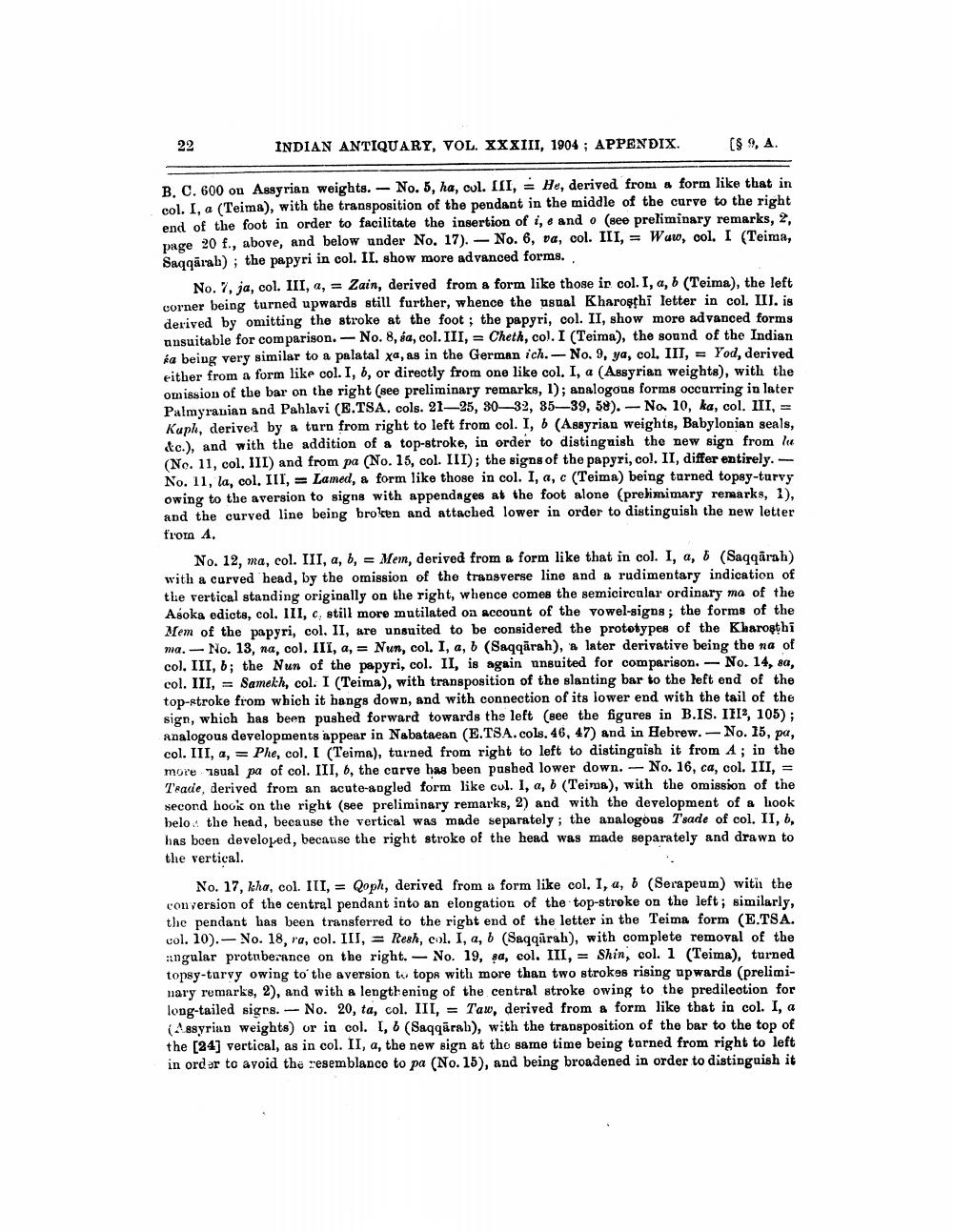________________
22
INDIAN ANTIQUARY, VOL. XXXIII, 1904; APPENDIX.
($ 9, A.
B. C. 600 on Assyrian weights. - No. 5, ha, col. III, = He, derived from a form like that in col. I, a (Teima), with the transposition of the pendant in the middle of the curve to the right end of the foot in order to facilitate the insertion of i, . and o (see preliminary remarks, 2, page 20 f., above, and below under No. 17). — No. 6, va, col. III, = Wow, col. I (Teima, Saqqarab), the papyri in col. II. show more advanced forms.
No., ja, col. III, a, = Zain, derived from a form like those ir col. I, a, b (Teima), the left corner being turned upwards still further, whence the usual Kharoshi letter in col. III. is derived by omitting the stroke at the foot; the papyri, col. II, show more advanced forms ansuitable for comparison. - No. 8, sa, col. III, = Cheth, col. I (Teima), the sound of the Indian ka being very similar to a palatal xa, as in the German ich.- No. 9, ya, col. III, = Yod, derived either from a form like col. I, 6, or directly from one like col. I, a (Assyrian weights), with the omission of the bar on the right (see preliminary remarks, 1); analogous forms occurring in later Palmyranian and Pahlavi (E.TSA, cols. 21-25, 30—32, 85-39, 58). - No. 10, ka, col. III, = Kuple, derived by a turn from right to left from col. I, 6 (Assyrian weights, Babylonian seals, &c.), and with the addition of a top-stroke, in order to distinguish the new sign from lu (No. 11, col. III) and from pa (No. 15, col. III); the signs of the papyri, col. II, differ entirely. - No. 11, la, col. III, = Lamed, a form like those in col. I, a, c (Teima) being torned topsy-turvy owing to the aversion to signs with appendages at the foot alone (prelimimary remarks, 1), and the curved line being broken and attached lower in order to distinguish the new letter from A.
No. 12, ma, col. III, a, b, = Mem, derived from a form like that in col. I, a, 6 (Saqqarah) with a curved head, by the omission of the transverse line and a rudimentary indication of the vertical standing originally on the right, whence comes the semicircular ordinary ma of the Asoka edicts, col. III, c, still more mutilated on account of the vowel-signs; the forms of the Mem of the papyri, col. II, are unsuited to be considered the prototypes of the Kharostbi ma. - No. 13, na, col. III, a, = Nun, col. I, a, b (Saqqarah), a later derivative being the na of col. III, b; the Nun of the papyri, col. II, is again unsuited for comparison. - No. 14, 8a, col. III, = Samekh, col. I (Teima), with transposition of the slanting bar to the left end of the top-stroke from which it hangs down, and with connection of its lower end with the tail of the sign, which has been pushed forward towards the left (see the figures in B.IS. 113, 105); analogous developments appear in Nabataean (E.TSA.cols. 46, 47) and in Hebrew. - No. 15, pa, col. III, a, = Phe, col. I (Teima), turned from right to left to distinguish it from A; in the more sual pa of col. III, 6, the carve has been pushed lower down. -- No. 16, ca, col. III, =
Teace, derived from an acute-angled form like cul. 1, a, b (Teima), with the omission of the second hook on the right (see preliminary remarks, 2) and with the development of a hook belo: the head, because the vertical was made separately, the analogous Tsade of col. II, 6, has been developed, because the right stroke of the head was made separately and drawn to the vertical.
No. 17, kha, col. III, = Qoph, derived from a form like col. I, a, b (Serapeum) witin the conversion of the central pendant into an elongation of the top-stroke on the left; similarly, the pendant has been transferred to the rigbt end of the letter in the Teima form (E.TSA. col. 10).- No. 18, ra, col. III, = Resh, col. I, a, 6 (Saqqarah), with complete removal of the ingular protuberance on the right. - No. 19, şa, col. III, = Shin, col. 1 (Teima), turned topsy-turvy owing to the aversion tu tops with more than two strokes rising upwards (preliminary remarks, 2), and with a lengthening of the central stroke owing to the predilection for long-tailed sigrs. - No. 20, ta, col. III, = Taw, derived from a form like that in col. I, a (Assyriad weights) or in col. 1, 6 (Saqqarab), with the transposition of the bar to the top of the [24] vertical, as in col. II, a, the new sign at the same time being turned from right to left in order to avoid the resemblance to pa (No. 15), and being broadened in order to distinguish it




